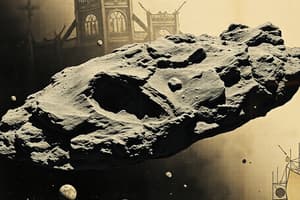Podcast
Questions and Answers
What provides possible insight into the composition of the outer early solar system?
What provides possible insight into the composition of the outer early solar system?
- Stars
- Asteroids
- Planets
- Comets (correct)
What is the nucleus of a comet?
What is the nucleus of a comet?
A small solid body from which the atmosphere is released.
What is a 'Dirty Snowball' in the context of comets?
What is a 'Dirty Snowball' in the context of comets?
A nucleus believed to consist of equal quantities of silicates and ice.
What is the main component of a comet's tail?
What is the main component of a comet's tail?
What are plasma tails characterized by?
What are plasma tails characterized by?
What is a dust tail?
What is a dust tail?
What causes a meteor shower?
What causes a meteor shower?
Crater structures on surfaces are probably caused by impacts.
Crater structures on surfaces are probably caused by impacts.
What happens to a comet over time?
What happens to a comet over time?
Long period comets originate from the ______.
Long period comets originate from the ______.
Short period comets come from the ______.
Short period comets come from the ______.
What is the origin of Earth's oceans believed to be?
What is the origin of Earth's oceans believed to be?
What are Kuiper Belt Objects (KBO)?
What are Kuiper Belt Objects (KBO)?
Pluto has cleared its orbital field.
Pluto has cleared its orbital field.
Flashcards are hidden until you start studying
Study Notes
Importance of Comets
- Comets offer insights into the early composition of the outer solar system.
- Asteroids are primarily rocky, while comets are icy structures.
Anatomy of a Comet
- Nucleus: Solid core believed to be a "dirty snowball" of silicates and ice.
- Coma: Atmosphere surrounding the nucleus.
- Tail: Streamers of gas and dust that form as the comet approaches the sun, often reaching lengths up to 1 AU by Mars' orbit.
Comet Tails
- Comets possess two types of tails: plasma tails and dust tails.
Plasma Tail
- Appears straight and extends directly away from the sun.
- Composed of ionized gas interacting with solar wind, exhibiting a blue color.
Dust Tail
- Displays a curved shape due to gravitational and solar pressure influences on dust grains.
- Typically yellow in color as it reflects sunlight.
Comets and Meteor Showers
- Meteor showers occur when Earth passes through the dust trails left by comets; particles are usually pea-sized.
Crater Structures on Comet Surfaces
- Crater formations on comet surfaces likely result from outgassing rather than impact events.
Death of a Comet: Three Possibilities
- Complete evaporation of icy materials, leaving no remnants.
- Evaporation of ices, resulting in leftover rocky materials that may evolve into Near-Earth Asteroids (NEAs).
- Collision with a planet or the sun leading to destruction.
Long Period Comets
- Possess extremely eccentric orbits with high inclinations to the ecliptic plane.
- Can have orbital periods reaching up to 1 million years.
- Originates from the Oort Cloud.
Short Period Comets
- Characterized by smaller inclinations and shorter orbital periods ranging from 20 to 100 years.
- Emerge from the Kuiper Belt.
Origin of Comets
- Oort Cloud: The main source of long-period comets, disturbed by the gravitational influence of passing stars.
- Kuiper Belt: Source of short-period comets, features a disk-like distribution of objects.
Origin of Earth's Oceans
- In its early stages, Earth was too hot for liquid water; however, water sources were mainly asteroids and some comets from the Jupiter family.
Kuiper Belt Objects (KBO)
- Located beyond Neptune's orbit, with many sharing orbits with Pluto.
- Classified into two groups: Classical KBOs and Scattering KBOs, stemming from leftover materials in the circumstellar disk.
Downfall of Pluto
- Pluto has not cleared its orbital neighborhood, co-existing with other KBOs.
- Its properties align closely with those of KBOs, but it is recognized as the largest among them.
Studying That Suits You
Use AI to generate personalized quizzes and flashcards to suit your learning preferences.




